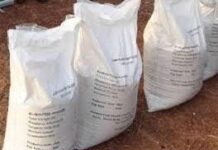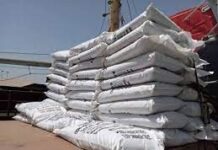With Abdoulie Dibba
FOCUS ON THE AGRICULTURAL PROGRAMS PART 1 This column is devoted to monitor and report on issues relating to food security in the Gambia as well as the interventions of Government and Non-governmental Organizations.
In this edition, we are focusing on the agricultural programs geared toward food security as well as the experiences of farmers regarding the impact of such programs on their lives.
Since 2000, a number of programs aimed at increasing food security have been elaborated and are in various stages of implementation.
In addition, government harmonized its sector policies and programs with global and regional initiatives such as the Millennium Development Goals
(MDGs), the Comprehensive Africa Agriculture Development Programme
(CAADP) of the New Partnership for Africa’s Development (NEPAD), and the Common Agriculture Policy (ECOWAP) of the Economic Community of West African States {ECOWAS).
During the decade, the priorities of the sector have been to achieve sustainable food security at the household and national levels. Toward this end, there are calls for the Agriculture and Natural Resource sector to be commercialized, while at the same time linking small and medium producers to improved technologies and markets, and increasing the competitiveness of the sector by reducing the domestic production costs, and improving quality.
The institutional structure of the sector is also being reformed to enable it meet the emerging trends. For example, given the increasing population of the country, there is more pressure on the land, and increased demands for food and better living standards. Furthermore, the relatively high poverty levels in the country pose serious threats to sustainable human development.
Against this background, there is now heightened awareness that the ANR sector can make significant contributions to national development. The sector has potential to enable the country attain self-sufficiency in food production, and make significant contributions to employment and incomes particularly for women and youths, as well as for development and growth.
For this reason, a new ANR policy has been elaborated to provide a framework for taking Gambian agriculture into the next century.
The ANR policy thus aims for a “robust, market oriented, commercialized sector that is directly aligned with the macro-economic framework of the country,” and contributes to the attainment of a “shared, inclusive and sustainable poverty reduction and economic growth in the Gambia.”
The ANR policy has four strategic objectives to be attained by 2015, and they are:
1). Improved and sustainable measurable levels of food and nutrition security in the country in general and vulnerable populations in particular
2). A commercialized ANR sector ensuring measurable competitive, efficient, and sustainable food and agricultural value chains, and linkages to markets
3). Institutions (public and private) in the sector are strengthened, and providing needed services, strong and enabling environment, and reducing vulnerability in food and nutrition security
4). Sustainable effective management of the natural resource base of the sector
Gambia National Agricultural Investment Program (GNAIP)
In 2005, ECOWAS agreed on an Action Plan (2005- 2010) to implement both the CAADP, and ECOWAP. ECOWAS was then mandated to implement the Action Plan, and consequently, the Regional Agricultural Investment Program (RAIP), which supplements national programs within the framework of the CAADP. The RAIP is sub-divided into the following six sub-programs:
1). Development of Agricultural chains and market promotion
2). Improvement of water management
3). Prevention and management of food crises and other natural disasters
4). Improved management of the other shared resources
5). Sustainable farm development
6). Institutional capacity building for the implementation of the RAIP
A key step toward the formulation of the RAIP is the preparation of National Agricultural Investment Programs (NAIPs) of ECOWAS member states.
These NAIPs are expected to be harmonized and consolidated, and thus form the basis of the RAIP. Towards this end, the Government of The Gambia, embarked on preparing a NAIP, with its two CAADP implementing ministries, the Ministry of Agriculture (MOA), and the Ministry of Trade, Industry, and Employment (MOTIE), spearheading the process.
The GNAIP was prepared in a highly consultative and participatory manner aimed at producing a document that is not only of the highest quality, but also has the ownership of the widest spectrum of stakeholders (government agencies, non-governmental organizations and the private sector). As a framework, the GNAIP is aimed at helping achieve the policies objectives of the ANR policy, which ultimately help the country achieve the MDGs. The GNAIP also provides the Gambia’s agricultural investment program in the six areas identified in the RAIP. The program is thus deeply rooted both in the national, regional, and international development frameworks and agenda.]]>
This column is devoted to monitor and report on issues relating to food security in the Gambia as well as the interventions of Government and Non-governmental Organizations.
In this edition, we are focusing on the agricultural programs geared toward food security as well as the experiences of farmers regarding the impact of such programs on their lives.
Since 2000, a number of programs aimed at increasing food security have been elaborated and are in various stages of implementation.
In addition, government harmonized its sector policies and programs with global and regional initiatives such as the Millennium Development Goals
(MDGs), the Comprehensive Africa Agriculture Development Programme
(CAADP) of the New Partnership for Africa’s Development (NEPAD), and the Common Agriculture Policy (ECOWAP) of the Economic Community of West African States {ECOWAS).
During the decade, the priorities of the sector have been to achieve sustainable food security at the household and national levels. Toward this end, there are calls for the Agriculture and Natural Resource sector to be commercialized, while at the same time linking small and medium producers to improved technologies and markets, and increasing the competitiveness of the sector by reducing the domestic production costs, and improving quality.
The institutional structure of the sector is also being reformed to enable it meet the emerging trends. For example, given the increasing population of the country, there is more pressure on the land, and increased demands for food and better living standards. Furthermore, the relatively high poverty levels in the country pose serious threats to sustainable human development.
Against this background, there is now heightened awareness that the ANR sector can make significant contributions to national development. The sector has potential to enable the country attain self-sufficiency in food production, and make significant contributions to employment and incomes particularly for women and youths, as well as for development and growth.
For this reason, a new ANR policy has been elaborated to provide a framework for taking Gambian agriculture into the next century.
The ANR policy thus aims for a “robust, market oriented, commercialized sector that is directly aligned with the macro-economic framework of the country,” and contributes to the attainment of a “shared, inclusive and sustainable poverty reduction and economic growth in the Gambia.”
The ANR policy has four strategic objectives to be attained by 2015, and they are:
1). Improved and sustainable measurable levels of food and nutrition security in the country in general and vulnerable populations in particular
2). A commercialized ANR sector ensuring measurable competitive, efficient, and sustainable food and agricultural value chains, and linkages to markets
3). Institutions (public and private) in the sector are strengthened, and providing needed services, strong and enabling environment, and reducing vulnerability in food and nutrition security
4). Sustainable effective management of the natural resource base of the sector
Gambia National Agricultural Investment Program (GNAIP)
In 2005, ECOWAS agreed on an Action Plan (2005- 2010) to implement both the CAADP, and ECOWAP. ECOWAS was then mandated to implement the Action Plan, and consequently, the Regional Agricultural Investment Program (RAIP), which supplements national programs within the framework of the CAADP. The RAIP is sub-divided into the following six sub-programs:
1). Development of Agricultural chains and market promotion
2). Improvement of water management
3). Prevention and management of food crises and other natural disasters
4). Improved management of the other shared resources
5). Sustainable farm development
6). Institutional capacity building for the implementation of the RAIP
A key step toward the formulation of the RAIP is the preparation of National Agricultural Investment Programs (NAIPs) of ECOWAS member states.
These NAIPs are expected to be harmonized and consolidated, and thus form the basis of the RAIP. Towards this end, the Government of The Gambia, embarked on preparing a NAIP, with its two CAADP implementing ministries, the Ministry of Agriculture (MOA), and the Ministry of Trade, Industry, and Employment (MOTIE), spearheading the process.
The GNAIP was prepared in a highly consultative and participatory manner aimed at producing a document that is not only of the highest quality, but also has the ownership of the widest spectrum of stakeholders (government agencies, non-governmental organizations and the private sector). As a framework, the GNAIP is aimed at helping achieve the policies objectives of the ANR policy, which ultimately help the country achieve the MDGs. The GNAIP also provides the Gambia’s agricultural investment program in the six areas identified in the RAIP. The program is thus deeply rooted both in the national, regional, and international development frameworks and agenda.]]>



















